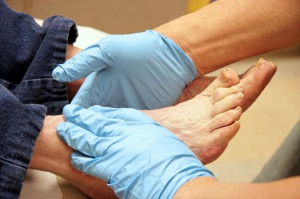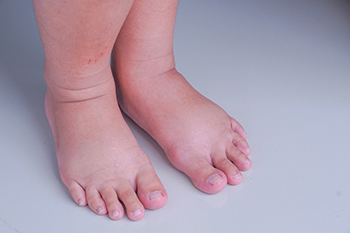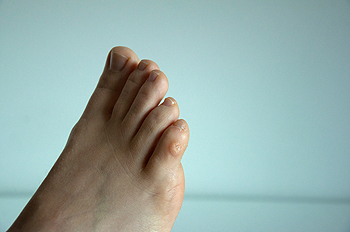Items filtered by date: June 2022
Walking Barefoot Is Not Suggested for Diabetic Patients

An elevated blood sugar level in the body may lead to a condition known as diabetes. It can damage the nerves in the feet and it can be difficult to feel existing cuts, bruises, or scrapes. An infected cut on the bottom of the foot could evolve into a foot ulcer, and the foot may have to be amputated if it is not promptly treated. It is important to perform proper diabetic foot care and this is done by using a mirror to check the bottom of the feet. Additionally, when the feet are washed and dried thoroughly, they will generally feel better. This can be followed by trimming the toenails straight across instead of curved. Many diabetic patients understand the importance of refraining from walking barefoot and this is an added measure in protecting the feet. Shoes are to be worn with socks that are well-padded and both need to be comfortable and fit properly. It is beneficial to purchase shoes at the end of the day when the feet are at their largest. Patients who have diabetes are suggested to be under the care of a podiatrist who can help them properly treat and manage their foot care issues.
Diabetic foot care is important in preventing foot ailments such as ulcers. If you are suffering from diabetes or have any other concerns about your feet, contact one of our podiatrist from North Texas Podiatry Associates. Our doctors can provide the care you need to keep you pain-free and on your feet.
Diabetic Foot Care
Diabetes affects millions of people every year. The condition can damage blood vessels in many parts of the body, especially the feet. Because of this, taking care of your feet is essential if you have diabetes, and having a podiatrist help monitor your foot health is highly recommended.
The Importance of Caring for Your Feet
- Routinely inspect your feet for bruises or sores.
- Wear socks that fit your feet comfortably.
- Wear comfortable shoes that provide adequate support.
Patients with diabetes should have their doctor monitor their blood levels, as blood sugar levels play such a huge role in diabetic care. Monitoring these levels on a regular basis is highly advised.
It is always best to inform your healthcare professional of any concerns you may have regarding your feet, especially for diabetic patients. Early treatment and routine foot examinations are keys to maintaining proper health, especially because severe complications can arise if proper treatment is not applied.
If you have any questions please feel free to contact our offices located in Euless and Southlake, TX . We offer the newest diagnostic and treatment technologies for all your foot and ankle needs.
Pregnancy and Edema

When excess fluid gathers in the tissues of your feet and ankles and causes swelling, it is known as edema. Edema is an unpleasant side effect most women experience during pregnancy, becoming quite uncomfortable in the third trimester. Edema during pregnancy is caused by a number of factors. First, when a woman is pregnant, their body retains more fluids. Also, their growing uterus places pressure on veins in the lower extremities, which slows the rate of blood returning back to the heart. This can cause blood and fluid to pool in the tissues of their feet and ankles. Pregnant women dealing with edema would do well to make an appointment with a podiatrist. With exercise recommendations, compression stockings, custom orthotics, and other foot care, a podiatrist can be very helpful to any pregnant woman who is struggling with edema.
Pregnant women with swollen feet can be treated with a variety of different methods that are readily available. For more information about other cures for swollen feet during pregnancy, consult with one of our podiatrist from North Texas Podiatry Associates. Our doctors will attend to all of your foot and ankle needs.
What Foot Problems Can Arise During Pregnancy?
One problem that can occur is overpronation, which occurs when the arch of the foot flattens and tends to roll inward. This can cause pain and discomfort in your heels while you’re walking or even just standing up, trying to support your baby.
Another problem is edema, or swelling in the extremities. This often affects the feet during pregnancy but tends to occur in the later stages.
How Can I Keep My Feet Healthy During Pregnancy?
- Wearing orthotics can provide extra support for the feet and help distribute weight evenly
- Minimize the amount of time spent walking barefoot
- Wear shoes with good arch support
- Wear shoes that allow for good circulation to the feet
- Elevate feet if you experience swelling
- Massage your feet
- Get regular, light exercise, such as walking, to promote blood circulation to the feet
If you have any questions please feel free to contact our offices located in Euless and Southlake, TX . We offer the newest diagnostic and treatment technologies for all your foot and ankle needs.
Three Types of Corns

A corn on the foot can cause extreme pain despite its small size. A corn is defined as a small area of hardened skin that generally forms on top of the toes, or on the side of the pinky toe. Some people have corns that develop between the toes which are referred to as soft corns. This can occur from wearing shoes that are too tight which may cause excess pressure. Additionally, seed corns are typically found on the soles of the foot and may be seen in clusters. Many patients can find relief when thinner socks are worn and larger shoes are purchased. A protective pad may be worn over the corn which may help to reduce existing friction. If the corns are severe and are interfering with daily activities, an X-ray may be taken which can help to determine the cause. It is advised that you schedule an appointment with a podiatrist if you suffer from corns, who can guide you toward correct options.
If you have any concerns regarding your feet and ankles, contact one of our podiatrist of North Texas Podiatry Associates. Our doctors will treat your foot and ankle needs.
Corns: What Are They? and How Do You Get Rid of Them?
Corns can be described as areas of the skin that have thickened to the point of becoming painful or irritating. They are often layers and layers of the skin that have become dry and rough, and are normally smaller than calluses.
Ways to Prevent Corns
There are many ways to get rid of painful corns such as wearing:
- Well-fitting socks
- Comfortable shoes that are not tight around your foot
- Shoes that offer support
Treating Corns
Treatment of corns involves removing the dead skin that has built up in the specific area of the foot. Consult with Our doctors to determine the best treatment option for your case of corns.
If you have any questions please feel free to contact our offices located in Euless and Southlake, TX . We offer the newest diagnostic and treatment technologies for all your foot and ankle needs.
Children, Physical Activity, and Sever’s Disease

The heel condition that is referred to as Sever’s disease generally affects children and young teenagers who are involved in sporting activities. The heel can often feel sore when Sever’s disease is present, and it may be difficult to walk. It is defined as a condition that affects the growth plate in the heel, and can be confirmed by having a physical examination performed. Relief is often found when the activity that caused the condition is stopped, and the heel is frequently rested. It is important to practice specific stretches once the heel feels better, and this may help to accelerate the recovery process. Many patients choose to wear a heel cushion in their shoe which may be able to provide additional padding. If your child is affected by Sever’s disease, it is advised that a podiatrist be consulted for proper prevention and healing tips.
Sever's disease often occurs in children and teens. If your child is experiencing foot or ankle pain, see one of our podiatrist from North Texas Podiatry Associates. Our doctors can treat your child’s foot and ankle needs.
Sever’s Disease
Sever’s disease is also known as calcaneal apophysitis, which is a medical condition that causes heel pain I none or both feet. The disease is known to affect children between the ages of 8 and 14.
Sever’s disease occurs when part of the child’s heel known as the growth plate (calcaneal epiphysis) is attached to the Achilles tendon. This area can suffer injury when the muscles and tendons of the growing foot do not keep pace with bone growth. Therefore, the constant pain which one experiences at the back of the heel will make the child unable to put any weight on the heel. The child is then forced to walk on their toes.
Symptoms
Acute pain – Pain associated with Sever’s disease is usually felt in the heel when the child engages in physical activity such as walking, jumping and or running.
Highly active – Children who are very active are among the most susceptible in experiencing Sever’s disease, because of the stress and tension placed on their feet.
If you have any questions, please feel free to contact our offices located in Euless and Southlake, TX . We offer the newest diagnostic and treatment technologies for all your foot and ankle injuries.

